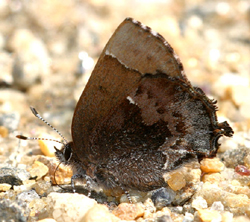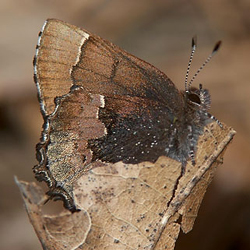Butterfly Atlas
Find a Butterfly
Henry's Elfin
Callophrys henrici
Named
Grote and Robinson, 1867

Taxonomy & Nomenclature
Taxonomic confusion between this species, I. irus, and I. polios have led to a series of errors in the literature. Opler (1984) states that "Henry‘s Elfin was misplaced for 40 years after its description, since biologists of the day used its Latin name for the Hoary Elfin, which had not yet been described."
Identification
Wingspan: 1". Of the five elfin species occurring in Massachusetts, this and Frosted Elfin (I. irus) are the only ones with stubby tails on the hindwing. Henry‘s Elfin, however, has a relatively straight postmedian line on the forewing below and lacks the thecla spots apparent on the frosted outer portion of the hindwing below in Frosted Elfin. The tone and pattern of the hindwing below also differ markedly from those of Frosted Elfin.
Distribution
Southeastern Manitoba east to Nova Scotia and south to eastern Oklahoma, central Texas, and central Florida. Southern New England north to southern Vermont and New Hampshire as well eastern Maine.
Status in Massachusetts
Uncommon; see, however, note regarding buckthorn under "Larval Food Plants" below. Records for this species during the Atlas period are concentrated in eastern Massachusetts. In the southeastern portion of the state Henry‘s Elfin was found in several areas on the west side of Buzzards Bay and at one location on the Lower Cape. Maximum: 8, 30 April 1994, Plum Island (Essex Co.).

Flight Period in Massachusetts
One flight: mainly late April to third week in May. Extreme dates: 15 April 1986, Wilmington (Middlesex Co.), S. Goldstein and 7 June 1988, No. Dartmouth (Bristol Co.), M. Mello.
Larval Food Plants
Feeds on many species of plants including members of the pea, rose and heath famlies (especially blueberries and huckleberries). It‘s ability to eat species of buckthorn - agressive invasives throughout the region - may allow this elfin to become more numerous and widespread.
Adult Food sources
Found at Low and High Bush Blueberries by Atlas workers. In addition, found "nectaring" at oak buds.

Habitat
Edges of wooded swamps and upland heaths, sand plains, and open pine oak woodlands where its food plants thrive.
Life Cycle
EGG: Light green; with numerous ridges. OVIPOSITION: Eggs are laid singly at various positions, including on flowers, leaf buds, and on underside of leaves. LARVA: Green or red with light dorsal and side stripes, and a series of yellow comma like marks. CHRYSALIS: Orange brown with dark mottling. Adults emerge in early spring, mate, and lay eggs. The caterpillars feed on fruits and flowers of their host plant for approximately one month before pupation. OVERWINTERING STAGE: Chrysalis PUPATION:
Account Author
Richard K. Walton



